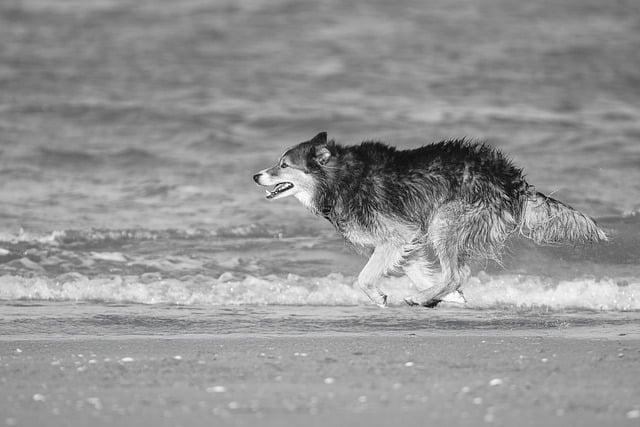Have you ever watched your dog suddenly sprint around the house, barking at invisible foes? It’s a scene that can leave any pet owner puzzled. But this seemingly random behavior is often a sign of a happy, healthy dog. Dogs have bursts of energy, known as the “zoomies,” which are their way of releasing pent-up excitement or stress. Understanding this quirky behavior can enhance your bond with your furry friend. Embrace these moments—they’re a testament to your dog’s joy and vitality, reminding us all to let loose and enjoy life!
Contents
- Understanding the Natural Instincts Behind Your Dogs Erratic Behavior
- Identifying Triggers: Environmental Factors That Spark Hyperactivity
- The Importance of Mental and Physical Stimulation for Your Dogs Well-Being
- Effective Strategies to Channel Your Dogs Energy into Positive Outlets
- Q&A
Understanding the Natural Instincts Behind Your Dogs Erratic Behavior
Dogs are fascinating creatures, driven by instincts that often manifest in unpredictable ways. Understanding these natural instincts can shed light on why your furry friend sometimes seems to act out of character. For instance, many dogs possess a strong prey drive, which can lead to sudden bursts of energy as they chase after imaginary prey or engage in playful antics. This behavior is deeply rooted in their ancestry, where hunting and chasing were essential for survival.
Another factor contributing to your dog’s erratic behavior is their social nature. Dogs are pack animals, and they thrive on interaction with their human companions and other dogs. When they feel excited or anxious, they may express this through hyperactive behavior, such as running in circles, barking, or engaging in playful wrestling. This is their way of communicating their emotions and seeking engagement, which can sometimes come across as chaotic.
Environmental factors also play a significant role in your dog’s behavior. Changes in their surroundings, such as new smells, sounds, or even the presence of other animals, can trigger instinctual responses. For example, a sudden noise might cause your dog to react with a burst of energy, leading to what appears to be erratic behavior. Additionally, boredom or lack of stimulation can prompt dogs to engage in wild antics as a way to entertain themselves.
Lastly, it’s essential to consider the role of genetics in your dog’s behavior. Certain breeds are predisposed to higher energy levels and more pronounced instincts. For instance, herding breeds may exhibit erratic behavior when they feel the need to “herd” their family members or other pets. Understanding your dog’s breed characteristics can help you anticipate and manage these instinctual behaviors, allowing you to provide appropriate outlets for their energy and instincts.
Identifying Triggers: Environmental Factors That Spark Hyperactivity
Understanding the environmental factors that can lead to sudden bursts of energy in dogs is crucial for pet owners. Various stimuli in their surroundings can trigger hyperactivity, often leaving owners puzzled about their pet’s erratic behavior. By recognizing these triggers, you can create a more harmonious environment for your furry friend.
One significant factor is **noise**. Loud sounds, such as thunderstorms, fireworks, or even the vacuum cleaner, can cause anxiety and lead to hyperactive responses. Dogs may react by running around, barking, or displaying other frantic behaviors. Observing your dog’s reaction to different sounds can help you identify specific noises that may be causing distress.
Another environmental element to consider is **social interactions**. Dogs are social creatures, and the presence of other animals or people can significantly influence their behavior. A visit from a lively friend or the sight of another dog can ignite excitement, prompting your pet to act out. Monitoring how your dog behaves during social gatherings can provide insights into their triggers and help you manage their energy levels during these interactions.
Lastly, **changes in routine** can also play a pivotal role in your dog’s hyperactivity. Dogs thrive on consistency, and any disruption—be it a new work schedule, a change in the household, or even a different walking route—can lead to confusion and excess energy. By maintaining a stable routine and gradually introducing changes, you can help your dog adjust and minimize hyperactive episodes.
The Importance of Mental and Physical Stimulation for Your Dogs Well-Being
Understanding your dog’s behavior is crucial for their overall health and happiness. One of the key factors that contribute to a well-adjusted canine companion is the right balance of mental and physical stimulation. Dogs are naturally energetic and curious creatures, and without adequate outlets for their energy and intellect, they may exhibit erratic behaviors that can be perplexing to their owners. Engaging your dog in various activities can help channel their energy positively, reducing instances of seemingly random craziness.
Physical exercise is essential for maintaining your dog’s physical health, but it also plays a significant role in their mental well-being. Regular walks, playtime, and interactive games not only help burn off excess energy but also promote a sense of routine and stability. Consider incorporating the following activities into your dog’s daily routine:
- Daily walks: Aim for at least 30 minutes of walking to stimulate both body and mind.
- Fetch and tug-of-war: These games provide an excellent outlet for energy while strengthening your bond.
- Agility training: Set up a simple obstacle course to challenge your dog physically and mentally.
In addition to physical activities, mental stimulation is equally important. Dogs thrive on challenges that engage their minds, preventing boredom and the behavioral issues that often accompany it. Activities that encourage problem-solving and creativity can significantly enhance your dog’s mental health. Consider these engaging options:
- Puzzle toys: These toys require dogs to think critically to access treats, keeping them entertained for hours.
- Training sessions: Teaching new commands or tricks not only stimulates your dog mentally but also reinforces good behavior.
- Scent games: Hide treats around the house or yard and let your dog use their nose to find them, tapping into their natural instincts.
By prioritizing both mental and physical stimulation, you can help your dog lead a more balanced and fulfilling life. When dogs are adequately exercised and mentally engaged, they are less likely to display erratic behaviors, making for a happier and more harmonious household. Remember, a well-stimulated dog is a content dog, and understanding their needs is the first step in nurturing their well-being.
Effective Strategies to Channel Your Dogs Energy into Positive Outlets
Dogs are naturally energetic creatures, and when that energy isn’t channeled properly, it can lead to unpredictable behavior. To transform your dog’s wild moments into constructive activities, consider incorporating a variety of engaging outlets into their daily routine. **Physical exercise** is paramount; activities such as brisk walks, runs, or play sessions in the yard can significantly reduce pent-up energy. Aim for at least 30 minutes of vigorous exercise each day, tailored to your dog’s breed and age.
In addition to physical activity, **mental stimulation** plays a crucial role in managing your dog’s energy levels. Engaging your dog in puzzle toys, interactive games, or obedience training can keep their mind sharp and focused. Activities like hide-and-seek or scent work can also provide a fun challenge, allowing your dog to use their natural instincts while expending energy in a positive way. Incorporating training sessions into your routine not only tires them out mentally but also strengthens your bond.
Socialization is another effective strategy to help your dog channel their energy. **Playdates with other dogs** or visits to dog parks can provide an outlet for social interaction and physical play. These environments allow your dog to engage in natural behaviors, such as running and playing, while also learning important social skills. Be sure to supervise these interactions to ensure they remain safe and enjoyable for all involved.
Lastly, consider incorporating **structured activities** into your dog’s routine. Sports like agility training, flyball, or even canine freestyle can be excellent ways to burn off excess energy while providing both physical and mental challenges. These activities not only keep your dog active but also offer opportunities for you to participate together, reinforcing your relationship and creating lasting memories. By implementing these strategies, you can help your dog thrive and minimize those unpredictable bursts of craziness.
Q&A
-
What causes sudden bursts of energy in dogs?
Dogs often experience sudden bursts of energy, commonly known as “zoomies.” This behavior can be triggered by factors such as:
- Excess energy from lack of exercise
- Excitement from playtime or new environments
- Stress relief after a period of calm
Providing regular exercise and mental stimulation can help manage these energetic episodes.
-
Is my dog acting crazy due to boredom?
Absolutely! Dogs require mental and physical engagement. If they are bored, they may resort to erratic behavior to entertain themselves. Consider:
- Interactive toys to stimulate their minds
- Regular walks and play sessions
- Training exercises to keep them focused
By enriching their environment, you can reduce these unpredictable antics.
-
Could my dog’s behavior indicate a health issue?
While occasional craziness is normal, sudden or extreme changes in behavior can signal health problems. Watch for:
- Changes in appetite or energy levels
- Signs of pain or discomfort
- Excessive barking or aggression
If you notice any concerning signs, consult your veterinarian to rule out medical issues.
-
How can I manage my dog’s crazy behavior?
Managing your dog’s unpredictable behavior involves a combination of strategies:
- Establish a consistent routine for exercise and play
- Provide mental stimulation through training and puzzles
- Monitor their environment for stressors
With patience and proper management, you can help your dog channel their energy more appropriately.
understanding your dog’s unpredictable behavior is key to fostering a harmonious relationship. By recognizing the triggers and providing appropriate outlets for their energy, you can ensure a happier, healthier, and more balanced life for your furry friend.

大家好,我是彼得潘,專業的手法身體治療師。我喜歡探索和研究各種主題,並透過與人工智慧的合作分享專業、實用、有趣的文章。我們定期進行人工審核,以確保內容的準確性。如果您發現文章中有任何不準確的地方,請隨時與我們聯繫,我們會及時糾正。您可以透過 [email protected] 與我們聯繫。



